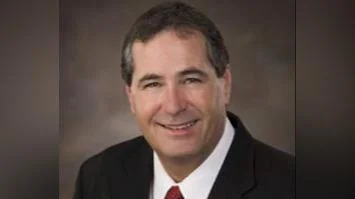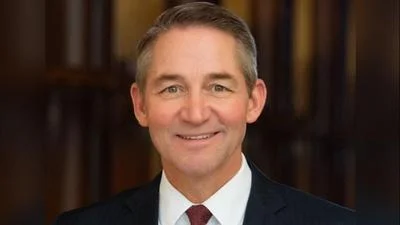John Lettieri, President and CEO of Economic Innovation Group | Official Website
John Lettieri, President and CEO of Economic Innovation Group | Official Website
Among North Dakota’s counties, Adams County saw the largest increase in transfer dependency over the past 10 years, surging 11.8% from 15.9% in 2012 to 27.7% in 2022, and up 19.5% from just 8.2% in 1970. In dollar terms, government transfers per capita in Adams County jumped from $11,215 in 2012 to $16,267 in 2022, a stark contrast to the $1,872 recorded in 1970.
Slope County followed with the second-largest increase in transfer dependency, increasing 9.6% from 8.2% in 2012 to 17.8% in 2022, and an overall increase of 13.3% from 1970’s 4.5% transfer dependency. This trend is reflected in per capita amounts, with residents of Slope County receiving an average of $10,190 in transfer income in 2022, up from $8,390 in 2012 and more than double the $1,872 recorded in 1970.
Additionally, Sioux County had the highest percentage of income derived from government transfers, at 38.7% in 2022, making it the county with the highest overall transfer dependency. Rolette County and Adams County followed, with transfer dependency rates of 33.5% and 27.7% in 2022, respectively.
Compared to 1970, Sioux County increased by 17.6%, while Rolette County and Adams County have increased by 12.9% and 19.5%, respectively, showing sustained reliance on government transfers. Residents in Sioux County received an average of $14,991 in transfers per capita, with Rolette County and Adams County close behind at $19,076 and $16,267, respectively.
For comparison, the statewide average was 14.1% in 2022, showing a lower dependency than the national average of 17.6%. On a per capita level, this translates to $9,913 per resident in 2022, compared to $11,542 nationwide.
Government transfer payments are non-repayable funds provided by federal, state, or local governments to support individuals in need. These payments aim to stabilize economic conditions and provide financial support during hardships. Key programs include Social Security transfers (retirement benefits), Medicare transfers (healthcare for seniors), Medicaid transfers (healthcare for low-income individuals), and income maintenance transfers (financial assistance for basic needs).
In North Dakota, reliance on government transfers was just 9.4% (or $1,876 per capita in inflation-adjusted 2022 dollars) in 1970. This has since increased to 14.1% (or $9,913 per capita) in 2022, reflecting a total increase of 4.7% since 1970. This shift is largely influenced by increased healthcare costs, and economic transformations that have reshaped income sources across the U.S.
In 2022, the primary government transfer programs in North Dakota included:
- Social Security: $3,356 per capita (33.9% of total transfers)
- Medicare: $2,340 per capita (23.6% of total transfers)
- Medicaid: $2,036 per capita (20.5% of total transfers)
- Income Maintenance Programs: $770 per capita (7.8% of total transfers)
With 16.6% of the population aged 65 and older, North Dakota has a significant demand for programs like Social Security and Medicare. However, counties with higher poverty rates also show elevated Medicaid and income maintenance participation.
Government transfers have long been a modest financial safety net, historically comprising only a small fraction of Americans' income. However, since the 1970s—sometimes dubbed the “Great Transfer-mation”—dependency has surged from 8.2% (or $2,022 per capita in inflation-adjusted 2022 dollars) in 1970 to 17.6% (or $11,542 per capita) in 2022 nationwide. In North Dakota, reliance on government transfers has similarly increased from 9.4% (or $1,876 per capita) in 1970 to 14.1% (or $9,913 per capita) in 2022.
According to the Economic Innovation Group’s analysis, these trends are not merely short-term responses to economic pressures but rather reflect a profound, long-term transformation in how government support is integrated into American life. The study illustrates that structural shifts—from rising healthcare expenses and demographic changes to stagnant wages—have significantly increased dependency on government transfers.
| County | Dependency on Transfers (%) | Change Since 2012 | Change Since 1970 | Per Capita Amount (2022) | Per Capita Change Since 2012 | Per Capita Change Since 1970 |
|---|---|---|---|---|---|---|
| Adams County | 27.7% | 11.8% | 19.5% | $16,267 | $5,052 | $14,395 |
| Barnes County | 17.8% | 2.7% | 6.1% | $13,491 | $3,584 | $11,258 |
| Benson County | 22.9% | 2.2% | 5.6% | $15,683 | $4,583 | $13,003 |
| Billings County | 6.8% | 1.3% | 2.6% | $5,653 | -$588 | $4,785 |
| Bottineau County | 16.2% | 4.1% | 4.7% | $14,564 | $4,017 | $12,379 |
| Bowman County | 18.7% | 8.1% | 9.3% | $14,020 | $4,866 | $12,017 |
| Burke County | 9.4% | 1.8% | -1.8% | $9,690 | $994 | $7,631 |
| Burleigh County | 13.4% | 1.8% | 6.8% | $9,577 | $1,965 | $8,111 |
| Cass County | 10.8% | 1% | 3.4% | $7,444 | $1,303 | $5,719 |
| Cavalier County | 10.7% | -1.2% | -0.9% | $14,531 | $3,586 | $12,485 |
| Dickey County | 15.9% | 2.4% | 3.9% | $14,804 | $4,258 | $12,628 |
| Divide County | 18.4% | 8% | 10.9% | $13,583 | $4,245 | $11,879 |
| Dunn County | 11.4% | 3.6% | 0.2% | $10,467 | $2,905 | $8,755 |
| Eddy County | 16.8% | -1.1% | 1.3% | $15,169 | $3,047 | $12,672 |
| Emmons County | 16.3% | -0.2% | 4.6% | $15,293 | $4,184 | $13,691 |
| Foster County | 12.8% | 1.2% | 1.9% | $11,693 | $2,234 | $9,656 |
| Golden Valley County | 17.4% | 5.8% | 8.8% | $9,894 | $2,396 | $7,982 |
| Grand Forks County | 14.7% | 1.9% | 8.3% | $8,964 | $1,974 | $7,547 |
| Grant County | 23.3% | 7.2% | 12.9% | $14,996 | $3,960 | $13,398 |
| Griggs County | 16.7% | 0.9% | 5.6% | $15,703 | $3,725 | $13,703 |
| Hettinger County | 19.6% | 7.4% | 11.2% | $13,197 | $3,027 | $11,585 |
| Kidder County | 17.5% | 2.2% | 7.7% | $14,601 | $4,060 | $12,936 |
| LaMoure County | 13.5% | 2.2% | 1.3% | $12,749 | $2,960 | $10,672 |
| Logan County | 18.2% | 2.7% | 5.8% | $15,539 | $4,115 | $13,798 |
| McHenry County | 17.7% | 4.3% | 4.5% | $13,835 | $4,401 | $11,511 |
| McIntosh County | 23.5% | 2.7% | 10.8% | $21,094 | $6,465 | $19,135 |
| McKenzie County | 7.3% | 0.4% | -0.1% | $5,568 | -$928 | $3,999 |
| McLean County | 17% | 2% | 5.6% | $13,771 | $3,453 | $11,674 |
| Mercer County | 19.3% | 5.7% | 9% | $12,778 | $4,444 | $10,735 |
| Morton County | 16.4% | 2.6% | 6.4% | $9,956 | $1,562 | $8,093 |
| Mountrail County | 12.8% | 3.2% | -1.5% | $10,398 | $2,330 | $8,013 |
| Nelson County | 20.7% | 0.7% | 6.9% | $19,084 | $4,483 | $16,334 |
| Oliver County | 15.2% | 2.9% | 9.2% | $9,563 | $1,645 | $8,454 |
| Pembina County | 15.2% | 1.3% | 1.7% | $13,336 | $3,676 | $10,863 |
| Pierce County | 20.2% | 2.5% | 9.1% | $15,101 | $4,785 | $13,199 |
| Ramsey County | 20.4% | 4.1% | 9.3% | $13,907 | $3,753 | $11,682 |
| Ransom County | 18.9% | 2.5% | 6.3% | $14,042 | $3,934 | $11,679 |
| Renville County | 13.3% | 2.9% | 3.3% | $15,048 | $5,042 | $13,226 |
| Richland County | 16.4% | 4.2% | 4.5% | $10,843 | $3,026 | $8,807 |
| Rolette County | 33.5% | 4.5% | 12.9% | $19,076 | $6,660 | $15,795 |
| Sargent County | 13% | 2.3% | 1.5% | $12,105 | $3,764 | $10,052 |
| Sheridan County | 15.2% | -3.5% | 5.4% | $15,039 | $2,419 | $13,224 |
| Sioux County | 38.7% | 7.9% | 17.6% | $14,991 | $4,107 | $11,668 |
| Slope County | 17.8% | 9.6% | 13.3% | $10,190 | $1,800 | $9,164 |
| Stark County | 12.6% | 4.8% | 3.9% | $8,426 | $1,155 | $6,909 |
| Steele County | 9.4% | 1.4% | -0.5% | $10,899 | $2,651 | $9,071 |
| Stutsman County | 18.2% | 3.1% | 8.1% | $12,343 | $3,048 | $10,356 |
| Towner County | 14% | -1.7% | 3.1% | $16,773 | $4,961 | $14,532 |
| Traill County | 17.3% | 3.4% | 4% | $13,043 | $3,465 | $10,636 |
| Walsh County | 19.6% | 3% | 7.1% | $14,881 | $4,516 | $12,630 |
| Ward County | 14.6% | 4.6% | 8.4% | $9,145 | $2,162 | $7,717 |
| Wells County | 15.1% | 0.1% | 2.3% | $16,511 | $4,377 | $14,219 |
| Williams County | 9.4% | 4.1% | -0.7% | $6,490 | -$81 | $4,458 |






 Alerts Sign-up
Alerts Sign-up